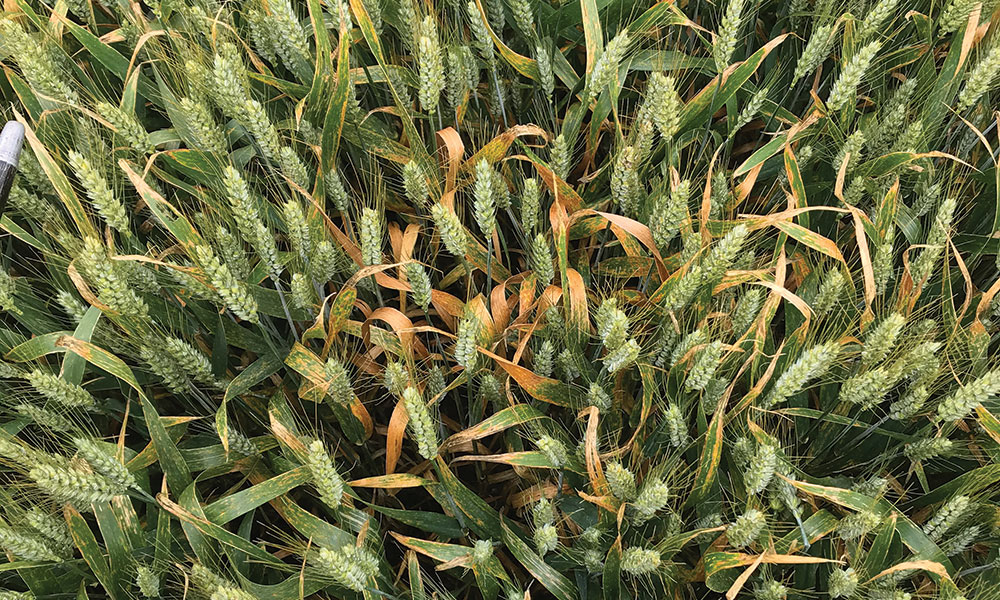01 March 2024
Cereal Killer
Zymoseptoria tritici continues to be highly destructive to cereal crops across Europe. However, advances in fungicide are seeking to manage future strains.

Further research into fungicides is needed to combat the pervasive crop disease Zymoseptoria tritici
In the early 1980s, Septoria tritici blotch (STB) or Zymoseptoria tritici came to be known as the most destructive disease to Irish winter wheat crops. While STB continues to be highly destructive, a combination of improved agronomy, genetics and fungicides means that Irish farmers have been able to minimise its potential impacts.
However, nature never stays still, and in the past decade significant changes in the causal pathogen Z. tritici — including the development of fungicide resistance and virulence — have meant that farmers have had to adjust their control programmes.
Fortunately, innovations in the form of new fungicide chemistries have helped. Both fenpicoxamid (Inatreq, developed by Corteva AgriSciences) and mefentrifluconazole (Revysol, developed by BASF) were registered for use in Irish fields in 2020, and are now key tools in the control of STB.
Contrasting starting points
Prior to their commercial launch, Inatreq and Revysol demonstrated greater efficacy than current fungicide standards, with European Z. tritici populations displaying sensitivity to both. However, the history of fungicide use in wheat crops means that these two fungicides may have been starting from different points in their sensitivity journey, explains Steven Kildea, a Research Officer in the Crops Research Centre at Teagasc Oak Park.
“Azole fungicides have been intensively used in wheat crops to control STB and other diseases for over 30 years. During this time Z. tritici has unfortunately developed mechanisms to survive the inhibitory effects of these fungicides. Whether these changes in the pathogen population impacted sensitivity to mefentrifluconazole remained unknown.
“Conversely, fenpicoxamid, as a Quinone inside Inhibitor (QiI), was a novel fungicide in cereals and, with no other fungicides acting on this specific target having ever been used in cereals, Z. tritici populations were presumably completely naïve. However, the history of fungicide usage to control Z. tritici has demonstrated that site-specific fungicides are often at risk of resistance development, with only a single change in the pathogen required to render the fungicide ineffective.”
For these reasons, it was important to establish a collection of isolates representative of European Z. tritici populations prior to the commercial use of either fungicide. As part of the EURORES project (Eurowheat Fungicide Resistance Network), populations of Z. tritici were collected from wheat crops in spring 2019 prior to fungicide applications in Ireland, Belgium, Denmark, Germany and Sweden. Using culture assays, the sensitivity of the collections to both fungicides were investigated, with differences being explored by examining the potential mechanisms of resistance that are known to exist in the pathogen.
Managing resistance
Unsurprisingly, differences in sensitivity were evident between the collections, irrespective of the fungicide tested. For both fungicides the Irish population was less sensitive when compared to those collected further east in Europe, in particular the Nordic countries, Steven explains.
“For mefentrifluconazole, this undoubtedly reflects the intensive azole use in winter wheat production in Ireland when compared to the Nordic countries, and evident by the presence of different target site mutations. The differences in sensitivity observed toward fenpicoxamid were not associated with target site changes.”
Glasshouse-based trials, using strains representative of the range of sensitivities present in European wheat fields, mirrored those of field trials conducted across the region. These trials also demonstrated the continued need for resistance management, to ensure that strains exhibiting greater resistance do not emerge and get selected.
As the recent history of fungicide usage in wheat in Europe has demonstrated, Z. tritici has an adept ability to overcome the inhibitory effect of fungicides, Steven says.
“As part of the EURORES project, and with knowledge of the target sites of the fungicides used for STB control — including mefentrifluconazole and fenpicoxamid — methods to rapidly screen populations were developed. These included probe-based and high-throughput assays based on Illumina sequencing. These allow us to screen populations for individual target site alterations or multiple alterations in the same gene respectively. A long-range multiplex sequencing assay based on PacBio sequencing provides knowledge of individual strains’ resistance status to multiple fungicide modes of actions.”
These assays will allow the detection of known or novel alterations that may impact fungicide sensitivity. Together with the network of researchers and agronomists established, they can be tracked across Europe and strategies implemented to prevent or delay their selection.
Acknowledgements
The authors would like to thank Pierre Hellin, Walloon Agricultural Research Center, Thies Heick, Aarhus University, and the wider EURORES Network. The research was conducted as part of the EURORES project, funded as part of the C-IPM (Coordinated Integrated Pest Management in Europe) ERANET.
Contributors
Steven Kildea
Principal Research Officer,
CELUP, Teagasc Oak Park.
stephen.kildea@teagasc.ie
Stephen Byrne
Senior Research Officer,
CELUP, Teagasc Oak Park.
Fiona Hutton
Technologist,
CELUP, Teagasc Oak Park.
[pic credit] Teagasc
Further reading
Z. Tritici sensitivity profiles observed for fenpicoxamid
Mefentrifluconazole sensitivity amongst European Zymoseptoria tritici populations
Multiplex qPCR assay for European populations of Zymoseptoria tritici
